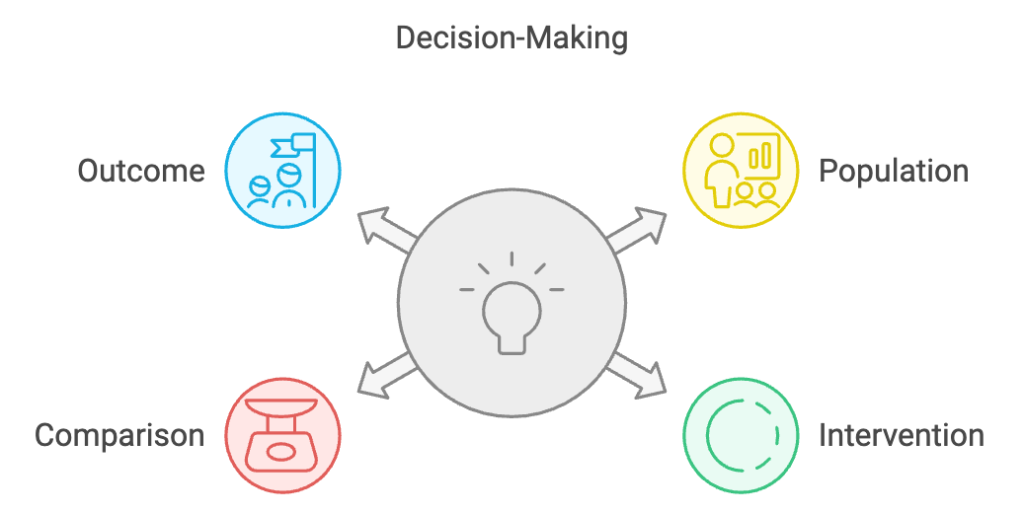Have you ever made a decision that you later regretted?
We’ve all been there. But what if I told you there’s a way to significantly improve your decision-making process?
Enter the world of evidence-based decision making.
In this post, we’ll dive deep into the what, why, and how of evidence-based decision making. Sfe!
What is Evidence-Based Decision Making?
Evidence-based decision making is exactly what it sounds like – making choices based on solid, verifiable evidence rather than gut feelings or assumptions. It’s about gathering relevant data, analyzing it critically, and using that information to inform your decisions.
This approach originated in medicine but has since spread to various fields, including business, education, and policy-making. The core principle is simple: use the best available evidence to make informed choices.
The Psychology Behind Decision Making
Before we dive deeper, let’s take a moment to understand how our brains make decisions. Psychologists have identified two main systems:
- System 1: Fast, intuitive, and emotional
- System 2: Slow, deliberate, and logical
Evidence-based decision making primarily engages System 2, but it’s important to recognize that both systems play a role in our choices. Understanding this dual-process theory can help us become more aware of our decision-making patterns and biases.
Types of Evidence: Not All Data is Created Equal
When it comes to evidence, quality matters. Here’s a quick rundown of different types of evidence, ranked from most to least reliable:
- Systematic reviews and meta-analyses
- Randomized controlled trials
- Cohort studies
- Case-control studies
- Cross-sectional surveys
- Case reports
- Expert opinions
Remember, the key is to use the highest quality evidence available for your specific situation.
The PICO Framework: A Structured Approach
One tool I’ve found incredibly useful in my decision-making process is the PICO framework. It stands for:
- Population: Who or what is affected by the decision?
- Intervention: What action are you considering?
- Comparison: What are the alternatives?
- Outcome: What do you hope to achieve?
Using this framework helps structure your thinking and ensures you’re considering all relevant factors.

Common Pitfalls and How to Avoid Them
Even with the best intentions, we can fall into traps when trying to make evidence-based decisions. Some common pitfalls include:
- Confirmation bias: Seeking out evidence that supports our pre-existing beliefs
- Analysis paralysis: Getting stuck gathering more and more data without making a decision
- Misinterpreting statistics: Drawing incorrect conclusions from data
To avoid these, stay aware of your biases, set deadlines for decisions, and don’t be afraid to ask for help interpreting complex data.
Tools and Techniques for Gathering Evidence
In today’s digital age, we have more tools than ever for gathering evidence. Some of my favorites include:
- Academic databases like Google Scholar or JSTOR
- Industry reports and white papers
- Surveys and customer feedback
- A/B testing for digital products
- Data analytics tools like Google Analytics
Personal Applications: From Diet to Relationships
Evidence-based decision making isn’t just for the boardroom. I’ve applied these principles to various aspects of my personal life, from choosing a diet plan to improving my relationships.
For example, when I decided to try intermittent fasting, I didn’t just jump on the bandwagon. I researched peer-reviewed studies, consulted with a nutritionist, and carefully tracked my own results. This approach helped me make an informed decision that worked for my body and lifestyle.
The Role of Intuition in Evidence-Based Decisions
Now, you might be thinking, “But what about gut feelings?” Great question! While evidence-based decision making emphasizes data, it doesn’t completely discard intuition. In fact, expert intuition, developed through years of experience, can be a valuable form of evidence.
The key is to use intuition as a starting point, then seek out evidence to confirm or challenge your gut feelings. This balanced approach can lead to more robust decisions.
Overcoming Cognitive Biases
We all have cognitive biases – mental shortcuts that can lead us astray. Some common ones include:
- Anchoring bias: Relying too heavily on the first piece of information we receive
- Availability bias: Overestimating the likelihood of events we can easily recall
- Sunk cost fallacy: Continuing a course of action because we’ve already invested in it
Recognizing these biases is the first step to overcoming them. Practice questioning your assumptions and seeking out diverse perspectives to challenge your thinking.
Case Studies: Success Stories and Lessons Learned
Let’s look at some real-world examples of evidence-based decision making in action:
Case Study 1: Netflix’s Content Strategy
Netflix uses data analytics to inform its content creation and acquisition decisions. By analyzing viewer behavior and preferences, they can predict which shows are likely to be successful, leading to hits like “Stranger Things” and “The Crown.”
Case Study 2: Procter & Gamble’s Product Development
P&G uses consumer research and market data to guide product development. This approach led to the creation of successful products like Swiffer, which addressed a clear consumer need identified through evidence-based research.
Ethical Considerations in Evidence-Based Approaches
While evidence-based decision making can be powerful, it’s crucial to consider ethical implications. Some key considerations include:
- Data privacy and consent
- Potential biases in data collection or analysis
- The impact of decisions on various stakeholders
Always strive to use evidence responsibly and ethically, considering the broader implications of your decisions.
Developing an Evidence-Based Mindset
Adopting an evidence-based approach is more than just following a set of steps – it’s about developing a new mindset. Here are some tips to cultivate this way of thinking:
- Stay curious and always ask “why?”
- Be open to changing your mind when presented with new evidence
- Practice critical thinking and question your assumptions
- Embrace uncertainty and view it as an opportunity to learn
Conclusion: Embracing a New Way of Thinking
Evidence-based decision making isn’t just a technique – it’s a philosophy that can transform the way you approach challenges and opportunities in all areas of life. By grounding our choices in solid evidence, we can increase our chances of success and minimize the risk of costly mistakes.
Remember, it’s not about making perfect decisions every time. It’s about consistently improving our decision-making process and learning from both our successes and failures. So, are you ready to embrace this powerful approach and take your decision-making skills to the next level?
TL;DR
Evidence-based decision making involves using the best available evidence to inform choices, rather than relying solely on intuition or assumptions. Key aspects include:
- Understanding different types of evidence and their reliability
- Using frameworks like PICO to structure your approach
- Avoiding common pitfalls like confirmation bias
- Applying the method in both business and personal contexts
- Balancing data-driven insights with expert intuition
- Considering ethical implications and future trends in decision making
By adopting an evidence-based mindset, you can make more informed decisions and improve outcomes in various aspects of life.
Q&A
- Q: Is evidence-based decision making only for big business decisions? A: Not at all! While it’s certainly valuable for major business decisions, evidence-based approaches can be applied to all kinds of choices, from personal health decisions to everyday problem-solving.
- Q: How do I start implementing evidence-based decision making in my life? A: Start small. Pick a decision you’re facing and try applying the PICO framework. Practice gathering and evaluating evidence from various sources. Over time, this approach will become more natural.
- Q: What if I don’t have access to all the data I need? A: Use the best evidence available to you. Sometimes, this might mean conducting your own small-scale experiments or surveys. Remember, some evidence is usually better than none.
- Q: How do I balance evidence-based decision making with the need to act quickly? A: Set time limits for your evidence-gathering phase. In fast-paced environments, you might need to make decisions with incomplete information. The key is to use the best evidence available within your time constraints.
- Q: Can evidence-based decision making eliminate all risks? A: While it can significantly reduce risks, it can’t eliminate them entirely. The goal is to make more informed decisions, not perfect ones. Always be prepared to adapt as new evidence emerges.
Evidence-Based Decision Making Quiz
Take this quiz to test your understanding of evidence-based decision making!
- Evidence-based decision making originated in which field? a) Business b) Medicine c) Psychology d) Education
- The PICO framework stands for: a) Problem, Intervention, Comparison, Outcome b) Population, Intervention, Comparison, Outcome c) Purpose, Information, Conclusion, Outcome d) People, Ideas, Context, Objectives
- Which of the following is considered the highest quality of evidence? a) Expert opinions b) Case reports c) Randomized controlled trials d) Systematic reviews and meta-analyses
- Evidence-based decision making primarily engages which system of thinking? a) System 1 (Fast and intuitive) b) System 2 (Slow and deliberate) c) Both equally d) Neither
- True or False: Evidence-based decision making completely eliminates the role of intuition in decision making. a) True b) False
Answers:
- b) Medicine
- b) Population, Intervention, Comparison, Outcome
- d) Systematic reviews and meta-analyses
- b) System 2 (Slow and deliberate)
- b) False
Scoring Interpretation:
- 5 correct: Excellent! You have a strong grasp of evidence-based decision making principles.
- 3-4 correct: Good job! You understand the basics but might want to review some concepts.
- 1-2 correct: You’re on the right track, but consider revisiting the key points in the article.
- 0 correct: Don’t worry! Everyone starts somewhere. Take another read through the article and try again.
Remember, understanding these concepts is just the first step. The real value comes from applying them in your daily life and decision-making processes. Start small, practice regularly, and you’ll soon see the benefits of this powerful approach!





